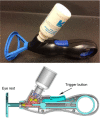An upright eyedrop bottle: accuracy, usage of excess drops, and contamination compared to a conventional bottle
- PMID: 27555747
- PMCID: PMC4968848
- DOI: 10.2147/OPTH.S104751
An upright eyedrop bottle: accuracy, usage of excess drops, and contamination compared to a conventional bottle
Abstract
Purpose: This study tested the feasibility of using an upright eyedrop bottle (UEB), a device designed to assist patients with eyedrop placement without reclining their head.
Patients and methods: Experienced eyedrop users were enrolled who answered "yes" to the question, "Do you ever have trouble getting your eyedrops in?" After being shown a multimedia presentation and answering a questionnaire regarding eyedrop usage, participants were observed instilling eyedrops. Participants were instructed to instill a single eyedrop in each eye with both a standard bottle and the UEB. They repeated this process three times. With each trial, the amount of time taken to instill drops was recorded, as well as whether a drop landed in the eye (accuracy), if excess drops were used, and if the bottle tip was contaminated.
Results: Forty participants were enrolled, with an average age of 72.4±8.9 years; the majority were females (24 females). Thirty-four participants had been using eyedrops for at least 1 year. The time required to instill eyedrops was significantly less with the UEB in the second and third trials. There was no difference in accuracy between the conventional bottle and the UEB in the left or right eye in any trials. Significantly more participants used excess number of drops while using the conventional bottle in both the left and right eyes in all three trials. The bottle tip was never contaminated with the UEB. Depending on the trial and the eye, the conventional bottle was contaminated by between 42% and 53% of participants.
Conclusion: The UEB has the potential to assist patients with eyedrop placement. Although there was no difference in accuracy between the UEB and the conventional bottle, the UEB was associated with less use of excess drops and less contamination of the bottle tip, compared to the conventional bottle.
Keywords: compliance; glaucoma; medical devices.
Figures
Similar articles
-
Reduction of Eyedrop Volume for Topical Ophthalmic Medications with the Nanodropper Bottle Adaptor.Med Devices (Auckl). 2023 Apr 6;16:71-79. doi: 10.2147/MDER.S397654. eCollection 2023. Med Devices (Auckl). 2023. PMID: 37056302 Free PMC article.
-
Evaluation of eyedrop administration by inexperienced patients after cataract surgery.J Cataract Refract Surg. 2014 Nov;40(11):1857-61. doi: 10.1016/j.jcrs.2014.02.037. Epub 2014 Sep 22. J Cataract Refract Surg. 2014. PMID: 25248295
-
An objective evaluation of eyedrop instillation in patients with glaucoma.Arch Ophthalmol. 2009 Jun;127(6):732-6. doi: 10.1001/archophthalmol.2009.96. Arch Ophthalmol. 2009. PMID: 19506189 Clinical Trial.
-
Eyedrop Instillation Techniques, Difficulties, and Currently Available Solutions: A Literature Review.J Curr Ophthalmol. 2024 Mar 29;35(3):226-230. doi: 10.4103/joco.joco_308_22. eCollection 2023 Jul-Sep. J Curr Ophthalmol. 2024. PMID: 38681691 Free PMC article. Review.
-
Videographic Assessment of Glaucoma Drop Instillation.J Curr Glaucoma Pract. 2015 May-Aug;9(2):47-50. doi: 10.5005/jp-journals-10008-1183. Epub 2015 Sep 25. J Curr Glaucoma Pract. 2015. PMID: 26997834 Free PMC article. Review.
Cited by
-
Improving Adherence to Topical Medication in Patients with Glaucoma.Patient Prefer Adherence. 2021 Jul 2;15:1477-1489. doi: 10.2147/PPA.S264926. eCollection 2021. Patient Prefer Adherence. 2021. PMID: 34239297 Free PMC article. Review.
-
Patients' Experience of Using Eye Drop Guide Device to Aid Self-Administration of Glaucoma Medications.Clin Ophthalmol. 2020 Nov 3;14:3781-3788. doi: 10.2147/OPTH.S271673. eCollection 2020. Clin Ophthalmol. 2020. PMID: 33177804 Free PMC article.
-
Impact of the Support, Educate, Empower Personalized Glaucoma Coaching Program Pilot Study on Eye Drop Instillation Technique and Self-Efficacy.Ophthalmol Glaucoma. 2021 Jan-Feb;4(1):42-50. doi: 10.1016/j.ogla.2020.08.003. Epub 2020 Aug 8. Ophthalmol Glaucoma. 2021. PMID: 32781286 Free PMC article.
-
Comparison of the Usability of Eye Drop Aids and the Conventional Bottle.J Clin Med. 2021 Nov 30;10(23):5658. doi: 10.3390/jcm10235658. J Clin Med. 2021. PMID: 34884360 Free PMC article.
References
-
- Stone JL, Robin AL, Novack GD, Covert DW, Cagle GD. An objective evaluation of eyedrop instillation in patients with glaucoma. Arch Ophthalmol. 2009;127(6):732–736. - PubMed
-
- Hennessy AL, Katz J, Covert D, et al. A video study of drop instillation in both glaucoma and retina patients with visual impairment. Am J Ophthalmol. 2011;152(6):982–988. - PubMed
-
- Brown MM, Brown GC, Spaeth GL. Improper topical self-administration of ocular medication among patients with glaucoma. Can J Ophthalmol. 1984;19(1):2–5. - PubMed
-
- Gupta R, Patil B, Shah BM, Bali SJ, Mishra SK, Dada T. Evaluating eye drop instillation technique in glaucoma patients. J Glaucoma. 2012;21(3):189–192. - PubMed
-
- Ostergaard Laursen S, Bjerrum P. Timolol eyedrop-induced severe bronchospasm. Acta Med Scand. 1982;211(6):505–506. - PubMed
Grants and funding
LinkOut - more resources
Full Text Sources
Other Literature Sources


